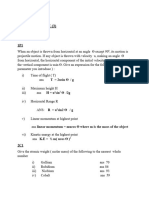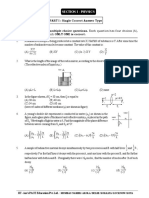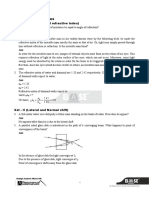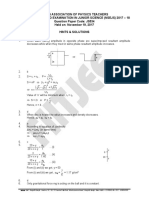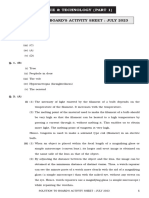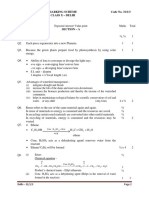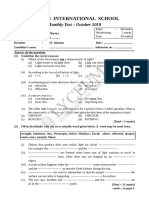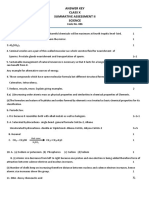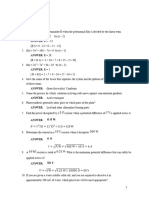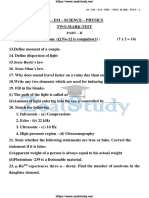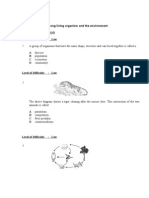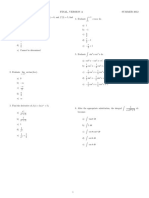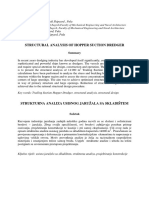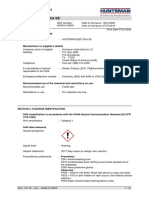X CBSE 2016 Science Solution
X CBSE 2016 Science Solution
Uploaded by
RAJESH KUMARCopyright:
Available Formats
X CBSE 2016 Science Solution
X CBSE 2016 Science Solution
Uploaded by
RAJESH KUMAROriginal Description:
Copyright
Available Formats
Share this document
Did you find this document useful?
Is this content inappropriate?
Copyright:
Available Formats
X CBSE 2016 Science Solution
X CBSE 2016 Science Solution
Uploaded by
RAJESH KUMARCopyright:
Available Formats
10 th CBSE (SESSION : 2015-16)
SUBJECT : SCIENCE
Pre-foundation Career Care Programmes (PCCP) Division SUMMATIVE ASSESSMENT-II
SOLUTION _SET-2_ CODE NO. 31/2
SECTION # A
1. CH3–CH2––CH2––CH2–OH
Butan – 1 – Ol
2. Hermophrodite or Bisexual
e.g. Earthworm
3. Ozone depletion
4. given m = – 3
informations obtained
Image Real
Inverted (m is negative)
Magnified (|m| > 1)
Mirror concave mirror
5. Forest serves as the reservoir of biodiversity containing different species of plants, animals.
• Biodiversity : Biodiversity means the number of species found In given area. The species can be
fungis, plants ferns, insects, Birds etc.
6. Water Harvesting : It is the collection of run off rainwater for reuse on - site, rather then allowing it for run
off.
This technique helps in the conservation of water.
(i) Reduces demand on ground water
(ii) Reduce flood and soil eosion.
(iii) Suitable for irrigation.
7. 2CH3–CH2––OH + 2Na 2CH3 – CH2–ONa + H2
Ethanol 'X' Sodium ethoxide 'Y'
Conc. H2SO 4
CH3–CH2–OH CH2=CH2 + H2O
'X' Ethene
8. C3H6O (1) aldehyde CH3–CH2–CHO
Propanal
(2) Ketone CH3–C–CH3
O
Acetone
Both are functional group isomer because they have same molecular formula.
9. (a) Valence electron = 6
Valency = 2
(b) H2S
electron dot structure H S H
(c) sulphur
non metal
10. (i) Element Atomic No. configuration Periodic no. Group No.
nd
X 7 2,5 2 15th
nd
Y 8 2,6 2 16th
nd
Z 9 2,8 2 17th
(ii) X,Y,Z belong to 2nd period, new electron enters into same shell as a result nuclear force of attraction
increases and atomic radii decreases.
X>Y>Z
(iii) 7X = 2,5 valency = 3
9
Z = 2,7 valency = 1
When 'X'combines with 'Z' it will form XZ3 type compound.
SOLUTION_10th CBSE(BOARD) _SUMMATIVE ASSESSMENT-II_SCIENCE_PAGE # 1
11. Reproduction is a process by which a living organism is able to produce more of its own kind.
(i) It provides stability stability to the population of species
(ii) It replenish the lost species of the population
(iii) It provide advantageous character to strugle for its survival.
Regenration : The ability of living organism to repair themselves or restore their lost part is called
regenration.
Regenration of Hydra : All body column cells are continuously undergoing mitosis. They migrate to the
extremities where they are eventually shed. Therefore, the Hydra is constantly regenerating.
12.
FISSION FRAGMENTATION
It is division produces two or more It is division where more than two cells are found
separate cells, species etc. depending upon the number of fragments.
which are Identical to each other
Cell are same in size & shape Cells do not have same size and Shape.
Occurs in unicellular organisms Occurs in multicellular organisms
e.g. Amoeba e.g. Amoeba
13. (a) (i) Progeny formed by sexual reproduction is the results of combination of the genetics material
from different individual.
(ii) Crossing over is the process occur during gametes production in which DNA is exchanged.
(b) (i) Pollen grain
(ii) Pollination
(iii) It provide pathway to pollen tube
(iv) Embryo formed after fertilization
14. Every species or organism has tendency for genetic variation which play important role in the origin of
new species and form basis for evolution.Classification involve organizing them in differentb groups based
on the similarities and differences of characterstics.It tells us about resemblances and relationship between
various organism facilitating studies or research. Classification of species a reflection of their evolutionary
relationship.Thus we can say that the area of study evulution and classification are interlinked.
15. Mendel”s experiment traits are inherited independently-
(i) When F1 Generation is self fertilized then various type of traits are seen in F2 generation.
(ii) In F2 generation, alleles get independently seperated from each other without contamination showing
their own traits.
(iii) Their traits show specific features when inherited to next generation.
A
E
F 2F
B
O B'
2F F
16.
A'
60 cm
Given m = –1, negative sign shows that image is real and inverted.
|m| = 1, it means that hi = ho
and this is only possible in convex lens.
object and image both will be at 2F
so, v = u
u = – 30 cm
v = + 30 cm
1 1 1
f v u
1 1 1
f 30 30
f = 15 cm
SOLUTION_10th CBSE(BOARD) _SUMMATIVE ASSESSMENT-II_SCIENCE_PAGE # 2
A'
A E
B' F B O F
Now, object is moved 20 cm towards the lens.
u = –10cm, v = ?, f = +15 cm
1 1 1 1 1 1 23
v = – 30 cm
f v u v 15 10 30
17. Activity : For this experiment, two prisms P1 and P2 of the same material and of the same refracting angle
A are arranged as shown in figure. Sunlight from a narrow slit S falls on the first prism P1 with its base
downwards and gets dispersed into constituent colours (VIBGYOR) and the bending takes place down-
wards. Now this dispersed light falls on the second prism P2 with its base upwards so that it deviates the
light upwards.
A PRISM (P2)
R R
ITE v v SCREEN
WH T
H
LIG
PRISM (P1) A
It is found that the light coming out of the second prism P2 is almost white and is in direction parallel to the
direction of light incident on the first prism P1. In fact, the two prisms P1 and P2 combined together
effectively acts like a parallel sided glass slab. This shows that the prism P1 simply disperses the white
light into its constituent colours and the prism P2 recombines these colours to form white light. The prism
P1 is called dispersing-prism and the prism P2 is known as recombination-prism.
18. (a) It is neccessory to conserve environment for protecting our atmosphere and living habitat from
degradation.
(b) Green dust-bin contain biodegradable waste or compostable material waste from landfills.
(c) Spread awarness in people to save environment.
He is also working hard for preventing environmental degradation of the sorrounding.
19. (a) Principal fos focal length :
First principal focus and first focal length : It is a fixed point on the principal axis such that rays
starting from this point (in convex lens) or appearing to go towards this point (concave lens), after refraction
through the lens, become parallel to the principal axis. It is represented by F1 or f. The plane passing
through this point and perpendicular to the principal axis is called the first focal plane. The distance between
first principal focus and the optical centre is called the first focal length. It is denoted by f1 or f.
f
Figure : Ray diagram showing First principal focus
SOLUTION_10th CBSE(BOARD) _SUMMATIVE ASSESSMENT-II_SCIENCE_PAGE # 3
Second principal focus and second focal length : It is a fixed point on the principal axis such that the
light rays incident parallel to the principal axis, after refraction through the lens, either converge to this
point (in convex lens) or appear to diverge from this point (in concave lens). The plane passing through
this point and perpendicular to principal axis is called the second focal plane. The distance between the
second principal focus and the optical centre is called the second focal length. It is denoted by f2 or f.
Figure : Ray diagram showing Second principal focus
(b) Given : divergent lens (concave lens)
f = – 30 cm, v = –15 cm , u = ?, h0 = 5 cm
1 1 1
f v u
1 1 1
30 15 u
u = – 30 cm
v hi
m= uh
o
hi = 2.5 cm G
A E
A'
(c) 2F B F B' O F
20. (i) f = –12 cm , range to obtain erect image 0 < u < 12
(ii) Image will be larger than object
(iii)
Given :
f = – 12 cm, u = –24 cm, v = ?
1 1 1
f v u
v = – 24 cm
SOLUTION_10th CBSE(BOARD) _SUMMATIVE ASSESSMENT-II_SCIENCE_PAGE # 4
21. Atmospheric Refraction : The density of the atmosphere, as we know goes on decreasing as the
distance above the sea level increases. The refractive index of a layer of air at a particular level goes on
changing. Due to this change in density the refraction take place when light passes through the Earth
atmosphere, this phenomena is called as atmpspheric refraction.
(a) Twinkling of stars : On a clear night, you might have observed the twinkling of a star, which is due
to an atmospheric refraction of star light. The density of the atmosphere, as we know goes on
decreasing as the distance above the sea level increases. For the sake of simplicity, air can be
supposed to be made up of a very large number of layers whose density decreases with the distance
above the surface of the earth. Therefore, the light from a heavenly body, such as a star, goes on
gradually bending towards normal as it travels through the earth’s atmosphere. As the object is
always seen in the direction of the light reaching the observer’s eye, the star appears higher up in the
sky than its actual position. Further, the densities of the various layers go on varying due to the
convection currents set up in air by temperature differences. Thus, the refractive index of a layer of air
at a particular level goes on changing.
Due to these variations in the refractive indices of the various layers of air, the light from a star passing
through the atmospheric air changes its path from time to time and therefore, the amount of light
reaching the eye is not always the same. This increase or decrease in the intensity of light reaching the
eye results in the change in apparent position or twinkling of the star.
(b) Advanced sun-rise and delayed sun set : Due to the atmospheric refraction, the sun is visible
before actual sunrise and after actual sunset.
Apparent
Position
S of Sun
Atmosphere
Horizon
Observer
Actual
S Position
Earth
of Sun
Refraction effect at sunset and sunrise
With altitude, the density and hence refractive index of air-layers decreases. The light rays starting from
the sun S travel from rarer to denser layers. They bend more and more towards the normal. However, an
observer sees an object in the direction of the rays reaching his eyes. So to an observer standing on the
earth, the sun which is actually in a position below the horizon, appears in the position S’, above the
horizon. The apparent shift in the position of the sun is by about 0.50. Thus the sun appears to rise early
by about 2 minutes and for the same reason, it appears to set late by about 2 minutes. This increases the
length of the day by about 4 minutes.
22. • Placenta : It is physical barrier connecting the embryo from the mother womb to the uterine wall to
allow nutrient uptake, waste removal, etc.
• Structure : In human Placenta is 22 cm (9 inch) in length 2 - 2.5 cm in thickness, weight 500 grm.
it has a dark reddish - blue or crimson color . It is discoidal in shape.
• Functions : –Provide nutrition to embryo
– Helps in excretion.
– Provide Immunity to the foetus
23. Evolution is change in the heritable traits of biological populations over successive generation.It occurs
due to it occurs due to continued mutation of natural selection.
They provide gradual change in phenotype which respect to shape and size of organism which also
indicate adaptation with respect to changing environmental condition.
Defination of fossile : The remains or Impression pre-historic plant or animal embedded. In rock and
preserved in petrified form. Fossil provide the evidence that present animals and Plants have originated
from previously existed ones through the process of continous evolution. e.g. fossile of Archaeopteryx
shows characteristics both reptile and birds.
It shows that aves has emerged from phylum reptiles.
SOLUTION_10th CBSE(BOARD) _SUMMATIVE ASSESSMENT-II_SCIENCE_PAGE # 5
24. Conc. H2SO 4
C2H5OH CH2= CH2 + H2O
'P' 'Q'
ethanol ethene
Ni
CH2= CH2 + H2 C2H6
'R'
ethane
Combustion
2C2H6 + 7O2 4CO2+ 6H2O
'R'
SECTION # B
25. (d) 26. (a) 27. (b) 28. (a) 29. (d) 30. (c) 31. (c)
32. (a) 33. (d)
A Second principal focus
E
F B'
2F B F O 2F
34. 5 cm
First principal focus
A'
Optical centre
Given : Convex lens
f = + 10 cm, u = –15 cm , v = ?, ho = 2.5 cm
1 1 1
f v u
1 1 1
10 v 15
v = 30 cm
v hi
m= uh
o
hi = – 5 cm
35. CH3COOH + NaHCO3 CH3COONa + H2O + CO2
Ethanoic acid Sodium bicarbonate Sodium acetate
When sodium bicarbonate is added to ethanoic acid a brisk effervescence due to evolution of CO2gas and
the temperature of flask increases.
36. The process is known as budding
SOLUTION_10th CBSE(BOARD) _SUMMATIVE ASSESSMENT-II_SCIENCE_PAGE # 6
You might also like
- Facet Bilge Water Separator CPS B MKIII & EBM14xDocument105 pagesFacet Bilge Water Separator CPS B MKIII & EBM14xLe Hoang75% (4)
- Well Point SystemDocument15 pagesWell Point SystemMostafa AbdellaNo ratings yet
- Line Sizing GuidelinesDocument31 pagesLine Sizing Guidelinesc_nghia100% (3)
- Class 3 Science WorkbookDocument14 pagesClass 3 Science WorkbookSathish Narayan33% (3)
- 10th Science Solutions 11 20 PDFDocument85 pages10th Science Solutions 11 20 PDFpankaj sonyNo ratings yet
- Class 10 Cbse Science Sample Paper Term 2 2012-13 Model 3Document11 pagesClass 10 Cbse Science Sample Paper Term 2 2012-13 Model 3Sunaina RawatNo ratings yet
- RSPL/1: CBSE Pariksha-2014 AnswersDocument8 pagesRSPL/1: CBSE Pariksha-2014 Answersprof_ktNo ratings yet
- Solution 1394434Document4 pagesSolution 1394434nootantripathiNo ratings yet
- New 432Document15 pagesNew 432mahidharmishra314No ratings yet
- Science X MS PB 2022-23 1-BDocument6 pagesScience X MS PB 2022-23 1-Byuvrajsinh jadejaNo ratings yet
- Science Set 3 Answer KeyDocument8 pagesScience Set 3 Answer Keymuskprincipal.2022No ratings yet
- Fhaltu 3.oDocument8 pagesFhaltu 3.omaheshpatidar2003No ratings yet
- Chennai Sahodaya Science 1ans KeyDocument5 pagesChennai Sahodaya Science 1ans KeyVarshith VNo ratings yet
- X GT-2 BATCH - 1 Science Answer KeyDocument5 pagesX GT-2 BATCH - 1 Science Answer Keykaniyamudhan7729No ratings yet
- Science Set 1 Answer KeyDocument8 pagesScience Set 1 Answer Keymuskprincipal.2022No ratings yet
- Fhaltu 3Document8 pagesFhaltu 3maheshpatidar2003No ratings yet
- FT Sci Set1 QP - 42928Document6 pagesFT Sci Set1 QP - 42928A BLESTNo ratings yet
- Contest ThreeDocument12 pagesContest Threeclaudiaglenn086No ratings yet
- X - Batch I - Science Answer KeyDocument7 pagesX - Batch I - Science Answer Keykaniyamudhan7729No ratings yet
- 2018 ScienceDocument16 pages2018 Scienceprem guptaNo ratings yet
- Important Question Class 10 Jan 2024Document5 pagesImportant Question Class 10 Jan 2024shaikh nagmaNo ratings yet
- Science Cbse Grade X 2011 Series RHB 1 Codeno 31 1 1Document12 pagesScience Cbse Grade X 2011 Series RHB 1 Codeno 31 1 1sarvesh kumarNo ratings yet
- Worksheet Holiday Homework Class 10-1Document2 pagesWorksheet Holiday Homework Class 10-1Himanshu YadavNo ratings yet
- 2017 Answer ScienceDocument12 pages2017 Answer Sciencemahidharmishra314No ratings yet
- 10th Holiday Homework - CBSE 01 FinalDocument6 pages10th Holiday Homework - CBSE 01 FinalPatel Om FUTURE IITIANNo ratings yet
- CBSE Class 10 Science Sample Paper Solution Set 2Document12 pagesCBSE Class 10 Science Sample Paper Solution Set 2ADWIN JESUSSTONNo ratings yet
- MQP Ans 02 01Document4 pagesMQP Ans 02 01Taqee MushrifNo ratings yet
- Aits 1 Part 2 EngineeringDocument26 pagesAits 1 Part 2 EngineeringFaham IITB CSENo ratings yet
- Biology P2 MS Form 4 2022 End Term 1 Teacher - Co - .KeDocument8 pagesBiology P2 MS Form 4 2022 End Term 1 Teacher - Co - .Kebethall1995No ratings yet
- Exam1 Solutions 1Document14 pagesExam1 Solutions 1Sai PragathiNo ratings yet
- Mandatory Exercise SolutionDocument14 pagesMandatory Exercise Solutionhemal mitreshNo ratings yet
- Important Instructions For The School Principal: (Not To Be Printed With The Question Paper)Document13 pagesImportant Instructions For The School Principal: (Not To Be Printed With The Question Paper)sharvan_creativeNo ratings yet
- Answer Key Science PRE BOARD II 2018 19Document21 pagesAnswer Key Science PRE BOARD II 2018 19AdtNo ratings yet
- Document PDF 287Document11 pagesDocument PDF 287AYUSH ANANDNo ratings yet
- Model Answers For High Achievers Q. No. Expected Answer: There AreDocument9 pagesModel Answers For High Achievers Q. No. Expected Answer: There AreVishwas MatondkarNo ratings yet
- Pre Board - 03 Key AnswersDocument9 pagesPre Board - 03 Key AnswersSuguna ANo ratings yet
- Class 8 Qp-Final-Term End 2Document7 pagesClass 8 Qp-Final-Term End 2mailjayaneNo ratings yet
- MS Science Set 4Document3 pagesMS Science Set 4Riya SharmaNo ratings yet
- PDF 6Document6 pagesPDF 6iamharsh2uNo ratings yet
- Science & Technology (Part 1) : Solution To Board'S Activity Sheet: July 2023Document4 pagesScience & Technology (Part 1) : Solution To Board'S Activity Sheet: July 2023roshanpardeshi984No ratings yet
- 10 Science CBSE Exam Papers 2016 Delhi Set 3 AnswersDocument6 pages10 Science CBSE Exam Papers 2016 Delhi Set 3 AnswersGokulNo ratings yet
- PhysicsDocument2 pagesPhysicsanurasNo ratings yet
- Optics 27 YearsDocument15 pagesOptics 27 YearssmrutirekhaNo ratings yet
- FT Sci Set1 Ak - 76140Document6 pagesFT Sci Set1 Ak - 76140A BLESTNo ratings yet
- Answer Key Class X Summative Assessment Ii Science: Code No. 086Document5 pagesAnswer Key Class X Summative Assessment Ii Science: Code No. 086ChandaNo ratings yet
- Class VII ScienceDocument4 pagesClass VII ScienceAkshara KarthikNo ratings yet
- X - Sci - Answer Key - Set ADocument13 pagesX - Sci - Answer Key - Set AIshaan YugNo ratings yet
- 10th QP PT 1Document3 pages10th QP PT 1pradeep dbNo ratings yet
- Contest 09Document9 pagesContest 09lorgic419No ratings yet
- Esrat Jahan Emu Lab2Document8 pagesEsrat Jahan Emu Lab2talukdertonmoy57No ratings yet
- 10 em Sci Full Portion 2 Mark QPDocument10 pages10 em Sci Full Portion 2 Mark QPbalansundara3No ratings yet
- Optics SheetDocument6 pagesOptics SheetDarsh GuptaNo ratings yet
- Ch-11 Wave Optics QB1Document12 pagesCh-11 Wave Optics QB1Angel SinghNo ratings yet
- Wave and Ray Optics Test Answer KeyDocument27 pagesWave and Ray Optics Test Answer KeynithishmjmmNo ratings yet
- Iinterdependence Among Living Arganism and Living ThingsDocument7 pagesIinterdependence Among Living Arganism and Living ThingsabdullmalikNo ratings yet
- CBSE Sample Papers Class 10 Science SA 2 Solved 2 PDFDocument15 pagesCBSE Sample Papers Class 10 Science SA 2 Solved 2 PDFDeep AdhiaNo ratings yet
- Science 9Document8 pagesScience 9Khushi AggarwalNo ratings yet
- CB G10 Sci Ye QPDocument8 pagesCB G10 Sci Ye QPProlay MondalNo ratings yet
- CLASS X SCIENCE (SP-08) 19-10-202begnegnegney4Document7 pagesCLASS X SCIENCE (SP-08) 19-10-202begnegnegney4pragunagarwalxNo ratings yet
- CBSC Class-9 Science SET-3: Section - ADocument11 pagesCBSC Class-9 Science SET-3: Section - AEliyasuddin AliNo ratings yet
- Board Preparatory Papers ScienceDocument5 pagesBoard Preparatory Papers ScienceSaatvik PradhanNo ratings yet
- Children's Encyclopedia Inventions and Discoveries: The world of knowledge for the inquisitive mindsFrom EverandChildren's Encyclopedia Inventions and Discoveries: The world of knowledge for the inquisitive mindsRating: 5 out of 5 stars5/5 (1)
- A Custodian of Grammar: Essays on Wittgenstein's Philosophical MorphologyFrom EverandA Custodian of Grammar: Essays on Wittgenstein's Philosophical MorphologyNo ratings yet
- News IndicatorDocument5 pagesNews IndicatorRAJESH KUMARNo ratings yet
- Ict MCQDocument15 pagesIct MCQRAJESH KUMARNo ratings yet
- 003) KVS TGT Maths Syllabus - Notes NADocument13 pages003) KVS TGT Maths Syllabus - Notes NARAJESH KUMARNo ratings yet
- Technical Analysis EnglishDocument30 pagesTechnical Analysis EnglishRAJESH KUMAR100% (1)
- Counterexamples in AnalysisDocument7 pagesCounterexamples in AnalysisRAJESH KUMARNo ratings yet
- Rajasthan Public Service Commission, AjmerDocument3 pagesRajasthan Public Service Commission, AjmerRAJESH KUMARNo ratings yet
- Mathematics Gate 2019 SyllabusDocument2 pagesMathematics Gate 2019 Syllabusap021No ratings yet
- MATH 141 Exam Ii Sample CDocument3 pagesMATH 141 Exam Ii Sample CRAJESH KUMARNo ratings yet
- AssignDocument1 pageAssignRAJESH KUMARNo ratings yet
- MATH 141 Exam Ii Sample ADocument3 pagesMATH 141 Exam Ii Sample ARAJESH KUMARNo ratings yet
- MATH 141 Final Exam Sample CDocument5 pagesMATH 141 Final Exam Sample CRAJESH KUMARNo ratings yet
- MATH 141, 141H Final Exam, Sample D: 2 2 3 2 0 Sin (X)Document4 pagesMATH 141, 141H Final Exam, Sample D: 2 2 3 2 0 Sin (X)RAJESH KUMARNo ratings yet
- MATH 141 Exam I, Version A FALL 2011Document5 pagesMATH 141 Exam I, Version A FALL 2011RAJESH KUMARNo ratings yet
- MATH 141 Final, Version A SUMMER 2012Document6 pagesMATH 141 Final, Version A SUMMER 2012RAJESH KUMARNo ratings yet
- Sample Exam.: Math 251H First Midterm ExamDocument8 pagesSample Exam.: Math 251H First Midterm ExamRAJESH KUMARNo ratings yet
- MSC Ent RSLTDocument100 pagesMSC Ent RSLTRAJESH KUMARNo ratings yet
- Credit Will Not Be Given For An Answer Unsupported by WorkDocument8 pagesCredit Will Not Be Given For An Answer Unsupported by WorkRAJESH KUMARNo ratings yet
- Structural Analysis of Hopper Suction DredgerDocument10 pagesStructural Analysis of Hopper Suction DredgerIvan GrbavacNo ratings yet
- Enterobacter and Other Coliform (Mucoidal, Convex Brownish Colonies)Document2 pagesEnterobacter and Other Coliform (Mucoidal, Convex Brownish Colonies)Esa Linus OrtizNo ratings yet
- Rebuilding of Boracay: Krah Pipes Are Used at Philippine IslandDocument40 pagesRebuilding of Boracay: Krah Pipes Are Used at Philippine IslandsegomezpNo ratings yet
- Cooling TowersDocument22 pagesCooling TowersvsrajguruNo ratings yet
- Philippines Green Building CodeDocument79 pagesPhilippines Green Building CodeRaphael Mana-ay100% (4)
- Hydroponics Farming-MICDocument17 pagesHydroponics Farming-MICIVAN JIRONGONo ratings yet
- Notice: Highway Planning and Construction Licenses, Permits, Approvals, Etc.: Montgomery and Prince George's Counties, MDDocument2 pagesNotice: Highway Planning and Construction Licenses, Permits, Approvals, Etc.: Montgomery and Prince George's Counties, MDJustia.comNo ratings yet
- Electrical Resistivity MethodDocument17 pagesElectrical Resistivity MethodVaishnav DineshNo ratings yet
- Contact ProcessDocument19 pagesContact ProcessLeela Santosh KumarNo ratings yet
- Paper vs. PlasticDocument29 pagesPaper vs. PlasticCari BalboaNo ratings yet
- Project On Green BuildingDocument29 pagesProject On Green BuildingKishalay Goswami100% (1)
- Muse Magazine Aprjune2016 Fa LoresDocument39 pagesMuse Magazine Aprjune2016 Fa LoresJuria TNo ratings yet
- G9 Geography Ch2 and 3 WorksheetDocument3 pagesG9 Geography Ch2 and 3 WorksheetA.G.V PublishersNo ratings yet
- Sanitary HospitalsDocument71 pagesSanitary Hospitalsdemullu reddiNo ratings yet
- Home Oxygen Concentrator: User Manaul Model No.:DE-1LWDocument17 pagesHome Oxygen Concentrator: User Manaul Model No.:DE-1LWAleerNo ratings yet
- Avitera Deep Sea SeDocument21 pagesAvitera Deep Sea SeKarim GaberNo ratings yet
- GS Paper (Author - Marish Valley Xaxa)Document90 pagesGS Paper (Author - Marish Valley Xaxa)Vineet SharmaNo ratings yet
- Toilet Standards For Hotels, Restaurants PDFDocument1 pageToilet Standards For Hotels, Restaurants PDFChristone ImmanuelNo ratings yet
- Assignment Topic:: Submiitted ToDocument13 pagesAssignment Topic:: Submiitted ToZobaer AhmedNo ratings yet
- Hydraulic Structures Ch3 - BizunehDocument115 pagesHydraulic Structures Ch3 - BizunehAshraf Bestawy73% (11)
- Mados ObrucheDocument14 pagesMados ObrucheMemoryNo ratings yet
- Effective Are Drainage in Mitigation Flood LossesDocument9 pagesEffective Are Drainage in Mitigation Flood LossesSusi MulyaniNo ratings yet
- Comparison Anti Fouling Coating 2020Document12 pagesComparison Anti Fouling Coating 2020Mohamad JammalNo ratings yet
- Insecticides Registered Under The Insecticides Act For Use in Household-Public Health-Rodent As On 30.06.2020Document6 pagesInsecticides Registered Under The Insecticides Act For Use in Household-Public Health-Rodent As On 30.06.2020Devendra KumarNo ratings yet
- Cresol: From Wikipedia, The Free EncyclopediaDocument6 pagesCresol: From Wikipedia, The Free EncyclopediapancabaNo ratings yet
- Seminar Solar Distillation 1Document14 pagesSeminar Solar Distillation 1Bharath BharmaNo ratings yet

















